[
Alchemist & MetaphysicianAuthor has 1.3K answers and 15.4M answer views11y
Originally Answered: What is the most amazing ancient, man made island?
Rising out of the South Pacific Ocean and appearing like a collection of huge stone “Log Cabin style” logs, Nan Madol is a relatively unknown wonder.
Please note: Everything you see below is built on man made islands, nearly 100 of them.

Tons of stone columns stacked into structures.
Located in the archipelago of Micronesia is the Caroline Islands. The largest island is Pohnpei, Pohnpei is in turn surrounded by dozens of smaller islands, including the island of Temwen. Temwen is the site of the megalith ruins of Nan Madol.

Example of a window built into the structure.
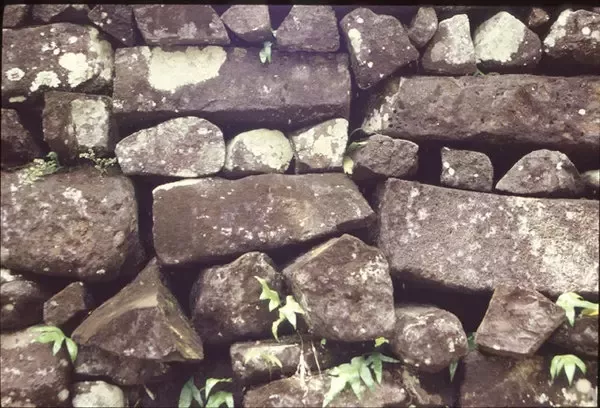
Closer detail of building technique.

Reiteration of the wall goes in to the water until it rests on a man made platform.
The Largest Discovery Of Man Made Islands
Nan Madol is a collection of 98 artificial islands that were created by stacking over 250,000,000 magnetized Prismatic Volcanic Basalt columns (http://en.wikipedia.org/wiki/Basalt), roughly 190 million tons covering over 11 square miles.
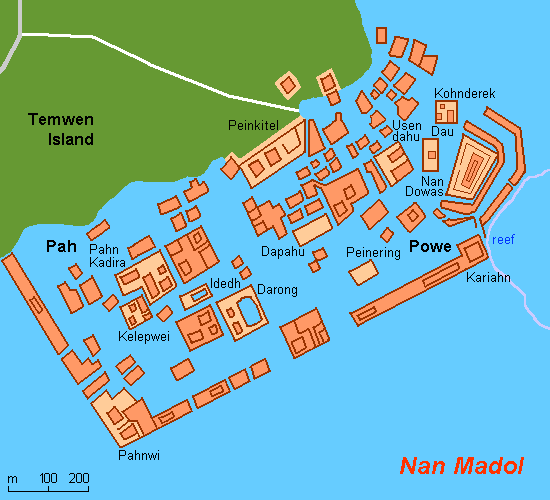
The average weight of the columns are 5 tons with some weighting over 25 tons. The constructed walls are generally 10 feet wide and over 37 feet tall. It is estimated that the largest mountain on Temwen is perhaps half the size needed to produce such a large quantity of Volcanic Basalt.

Single columns running 50 feet long.
The Mountain Of Quarry Stone For Nan Madol Can Not Be Found
It has been presumed and thus repeated by notable researchers that the rock came from an area north of the island called Sokehs Rocks. There are two rather large issues with this postulation, 1) There is no significant evidence that any large scale mining took place, 2) perhaps more to the issue, there would have been an entire mountain missing and thus far no one has been able to find the area where the mountain disappeared.
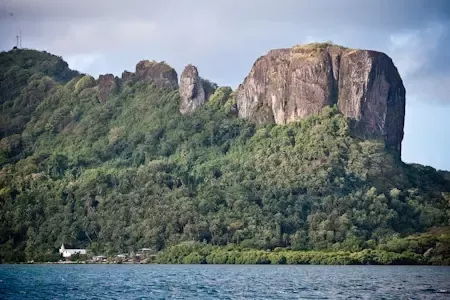
Sokehs Rock, proposed site of the Nan Madol Quarry.
Primitive Bamboo Boats Failed To Float Basalt Columns
Perplexing is how the Basalt columns were transported to the building site. If the norther Sokehs Rocks was the Quarry site, it would have been impossible, using any practical and understood system to navigate the mountain that block the North side of the island from the South. The only postulation from researchers was simple bamboo rafts moved the stones. In 1995 the Discovery Channel visited the island to produce a documentary movie to test the science behind the theory. Using even more modern boat building techniques, all attempts to transport columns weighing over one ton failed. 85% of the columns are far heavier than one ton.

Example of larger granite rocks used in some of the construction.
Far Older Than Originally Thought
Nan Madol has had continual habitation for far longer than current pottery analyst has suggested. Sea level analysis, study of ocean-floor sediment, and examination of surrounding semi-submerged ruins at the base of Nan Madol structures and in the surrounding waters put the approximate date for construction at approximately 12,000 years ago. There is compelling evidence that the site was constructed when the level of the Pacific ocean was lower. Dr. Pensile Lawrence, the former director of the Pohnpei Museum postulated that his research confirms that below Nan Madol is a more recent build of a acient “sunken city” and is 100s of feet deep. He has evidence that he will publish that detail the layers he has discovered and he is currently placing the age to be before 12,000 years ago.
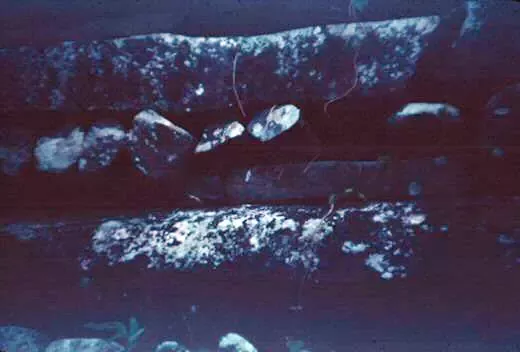
Below the water is the same building style on top of 500 ton flat bases.
Like any site that had been used over 1000s of years, it is natural to see pieces of the prior epochs intermixed with the more ancient. The broader carbon dating in 1960 by a team sent by the Smithsonian tested broken pottery shards found below artificial fill at Nan Madol’s Dapahu Islet dated to 2,000 years ago. They also find a fire pit and dug to reach what they thought was the bottom and dated the carbon found in this pit. They set this date to be about 100 ACE. It is important to note that pottery has never been known to be used on or near the island and the natives had no knowledge of pottery prior to its introduction in the 1800s. One would have to conclude that Pottery tests prove that someone dropped a jug there that may have been an early visitor to the island that had knowledge of pottery. However, it would be flawed logic to use this fragment of pottery to place the construction date for Nan Madol. It is unfortunate that this dating has been tied to the site in a rather permanent manner as there is far more archaeology that can be done that perhaps could reveal far more details.
Newer Culture Repurposing Older Areas
The Saudelaur Dynasty is usually attributed with the construction of Nan Madol from 500 to 1450. However the oral and written history from the descendants speak about two brothers Olisihpa and Olosohpa were in search of a place to build an altar so that they could worship Nahnisohn Sahpw, the God of Agriculture. When they arrived, they found the remnants of a far more ancient culture. They saw towering structures that rose out of the bay and thought they have found the place to pay tribute to Nahnisohn Sahpw.
A deeper study of the site can show where the more modern building techniques (perhaps 1000 to 1200 ACE) are mixed in with the more ancient (perhaps 5000+ BCE). It is abundantly clear that the large and far heaver Volcanic Basalt columns are the older construction. The stone cutting techniques are noticeably different and none of the inhabitants of the last 150 years knew how to work stone in this manner.
A Network Of Tunnels
The currently accepted theory does not address the 100s of tunnels that are below Nan Madol and most of the island of Temwen. In fact there is very little published even in the most comprehensive studies of this area.

Example of a stark wall corner on Nam Madol.
A Sinking City?
It has been speculated that Nan Madol has been slowly sinking for 100s of years and at one point most of the building below the surface was above the water line. This may help explain the areas that are now submerged and appear to be tunnels.
Why Build Man Made Islands When There Are Thousands All Around This Area?
The location Nan Madol raises a number of baffling question, why build in the bay by the island of Temwen, when the island had far more suitable living areas? Each structure had to be built on a specially constructed artificial stone rectangle in the water up to 60 feet deep, edged by the long Volcanic Basalt columns and filled with millions of tons of coral granules.
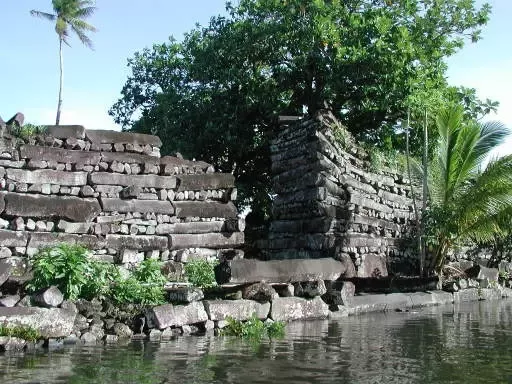
Example of large “Doorways” on Nam Madol.
And if they did not for some reason want to inhabit the island, what motivated this rather insane building project that took perhaps 100s of years with demanding the grueling labor to build artificial sea islands when there are 100s far larger natural coral reef islands to build on?

Example of an entrance area on Nam Madol.
It Takes A Lot Of People To Move 250 Million Rock Columns
Adding to the perplexing nature of Nan Madol is, where the 100s if not 1000s of workers came from and lived. Neither the island of Temuen, where Nan Madol is situated, nor neighboring islands could support a human population large enough to accomplish such an astonishing feat of engineering and building consistently for the 100s of years needed to complete the project.
There is no evidence of over population in this region and food and potable water was abundant.
There are no signs of very long wars that some suggest prompted this building. There is no significant defense advantage to this building as it would be highly indefensible by it’s design.

Russian researchers go underwater to confirm 12,000 year old dating of Nan Madol:
- http://www.dailymotion.com/video/xbn8fh_nan-madol-2-antediluvian-mysteries_webcam
- http://www.dailymotion.com/video/xbn8mj_nan-madol-1-antediluvian-mysteries_tech
There have been many fantastic and rather mundane speculations on every aspect of Nan Madol. None have been particularly satisfying. Any researcher that make the claim that the “Mystery” has been solved is certainly not addressing every aspect of this site. Although some have tried to write off Nan Madol as some project of bored islanders in the 1600s. This would have to meet Occams Razor (http://en.wikipedia.org/wiki/Occam’s_razor) as an extraordinary claim.

Nan Madol is:
- A whole lot of stacked rock logs.
- Moved a meaningfully far distance.
- Using unknown modes of transportation.
- Built in more than shallow water.
- By people that history can not account for.
- Using building techniques that are not fully understood today
- For a purpose that is not clear.
- In a period that could span as far back as 12,000 years.
